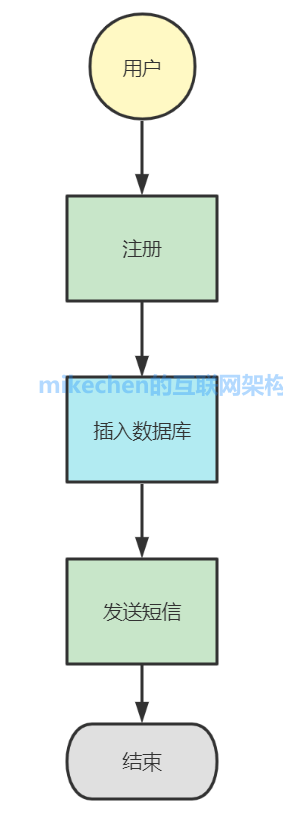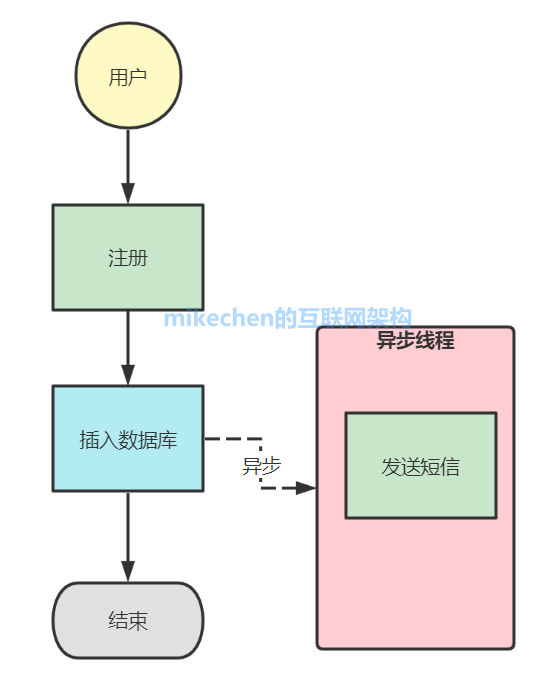| Java 异步编程 (5 种异步实现方式详解) | 您所在的位置:网站首页 › java webservice接口异步调用 › Java 异步编程 (5 种异步实现方式详解) |
Java 异步编程 (5 种异步实现方式详解)
|
同步操作如果遇到一个耗时的方法,需要阻塞等待,那么我们有没有办法解决呢?让它异步执行,下面我会详解异步及实现@mikechen 目录 什么是异步? 一、线程异步 二、Future异步 三、CompletableFuture异步 四、SpringBoot @Async异步 五、Guava异步 Java异步编程小结 什么是异步?首先我们先来看看一个同步的用户注册例子,流程如下:
在同步操作中,我们执行到插入数据库的时候,我们必须等待这个方法彻底执行完才能执行“发送短信”这个操作,如果插入数据库这个动作执行时间较长,发送短信需要等待,这就是典型的同步场景。 于是聪明的人们开始思考,如果两者关联性不强,能不能将一些非核心业务从主流程中剥离出来,于是有了异步编程雏形,改进后的流程如下:
在聊完异步编程后,那么我们一起来看看Java里面实现异步编程究竟有哪些方式呢? 一、线程异步 在 Java 语言中最简单使用异步编程的方式就是创建一个 线程来实现,如果你使用的 JDK 版本是 8 以上的话,可以使用 Lambda 表达式 会更加简洁。 public class AsyncThread extends Thread{ @Override public void run() { System.out.println("当前线程名称:" + this.getName() + ", 执行线程名称:" + Thread.currentThread().getName() + "-hello"); } }public static void main(String[] args) { // 模拟业务流程 // ....... // 创建异步线程 AsyncThread asyncThread = new AsyncThread(); // 启动异步线程 asyncThread.start(); }
当然如果每次都创建一个 Thread线程,频繁的创建、销毁,浪费系统资源,我们可以采用线程池: private ExecutorService executor = Executors.newCachedThreadPool() ; public void fun() throws Exception { executor.submit(new Runnable(){ @override public void run() { try { //要执行的业务代码,我们这里没有写方法,可以让线程休息几秒进行测试 Thread.sleep(10000); System.out.print("睡够啦~"); }catch(Exception e) { throw new RuntimeException("报错啦!!"); } } }); }
将业务逻辑封装到 Runnable 或 Callable 中,交由 线程池 来执行。 二、Future异步 上述方式虽然达到了多线程并行处理,但有些业务不仅仅要执行过程,还要获取执行结果,后续提供在JUC包增加了Future。 从字面意思理解就是未来的意思,但使用起来却着实有点鸡肋,并不能实现真正意义上的异步,获取结果时需要阻塞线程,或者不断轮询。 @Test public void futureTest() throws Exception { System.out.println("main函数开始执行"); ExecutorService executor = Executors.newFixedThreadPool(1); Future future = executor.submit(new Callable() { @Override public Integer call() throws Exception { System.out.println("===task start==="); Thread.sleep(5000); System.out.println("===task finish==="); return 3; } }); //这里需要返回值时会阻塞主线程,如果不需要返回值使用是OK的。倒也还能接收 //Integer result=future.get(); System.out.println("main函数执行结束"); System.in.read(); }三、CompletableFuture异步 Future 类通过 get() 方法阻塞等待获取异步执行的运行结果,性能比较差。 JDK1.8 中,Java 提供了 CompletableFuture 类,它是基于异步函数式编程。相对阻塞式等待返回结果,CompletableFuture 可以通过回调的方式来处理计算结果,实现了异步非阻塞,性能更优。 CompletableFuture 实现了 Future 和 CompletionStage 接口, 并提供了多种实现异步编程的方法,如supplyAsync, runAsync以及thenApplyAsync。 下面我们使用CompletableFuture来实现上面的例子: CompletableFuture completableFuture = CompletableFuture.supplyAsync(() -> factorial(number)); while (!completableFuture.isDone()) { System.out.println("CompletableFuture is not finished yet..."); } long result = completableFuture.get();
我们不需要显式使用 ExecutorService,CompletableFuture 内部使用了 ForkJoinPool 来处理异步任务,这使得我们的代码变的更简洁。 四、SpringBoot @Async异步 在@Async注解之前,使用多线程需要使用JDK的原生方法,非常麻烦,当有了@Async之后就比较简单了。 首先,使用 @EnableAsync 启用异步注解: @SpringBootApplication @EnableAsync public class StartApplication { public static void main(String[] args) { SpringApplication.run(StartApplication.class, args); } }
自定义线程池: @Configuration @Slf4j public class ThreadPoolConfiguration { @Bean(name = "defaultThreadPoolExecutor", destroyMethod = "shutdown") public ThreadPoolExecutor systemCheckPoolExecutorService() { return new ThreadPoolExecutor(3, 10, 60, TimeUnit.SECONDS, new LinkedBlockingQueue(10000), new ThreadFactoryBuilder().setNameFormat("default-executor-%d").build(), (r, executor) -> log.error("system pool is full! ")); } }
在异步处理的方法上添加注解 @Async ,当对 execute 方法 调用时,通过自定义的线程池 defaultThreadPoolExecutor 异步化执行 execute 方法 @Service public class AsyncServiceImpl implements AsyncService { @Async("defaultThreadPoolExecutor") public Boolean execute(Integer num) { System.out.println("线程:" + Thread.currentThread().getName() + " , 任务:" + num); return true; } } 用 @Async 注解标记的方法,称为异步方法。在spring boot应用中使用 @Async 很简单: 调用异步方法类上或者启动类加上注解 @EnableAsync 在需要被异步调用的方法外加上 @Async 所使用的 @Async 注解方法的类对象应该是Spring容器管理的bean对象; 五、Guava异步 Guava 提供了 ListenableFuture 类来执行异步操作 1.首先我们需要添加 guava 的maven依赖: com.google.guava guava 28.2-jre
2.现在我们使用ListenableFuture来实现我们之前的例子: ExecutorService threadpool = Executors.newCachedThreadPool(); ListeningExecutorService service = MoreExecutors.listeningDecorator(threadpool); ListenableFuture guavaFuture = (ListenableFuture) service.submit(()-> factorial(number)); long result = guavaFuture.get();
这里使用MoreExecutors获取ListeningExecutorService类的实例,然后ListeningExecutorService.submit执行异步任务,并返回 ListenableFuture实例。 Java异步编程小结 异步编程受到了越来越多的关注,尤其是在 IO 密集型的业务场景中,相比传统的同步开发模式,异步编程的优势越来越明显,希望以上介绍的5种Java异步编程方式对你有所帮助! 作者简介陈睿|mikechen,10年+大厂架构经验,《BAT架构技术500期》系列文章作者,分享十余年BAT架构经验以及面试心得! 阅读mikechen的互联网架构更多技术文章合集 Java并发|JVM|MySQL|Spring|Redis|分布式|高并发|架构师
|
【本文地址】


 这就是异步编程,它是程序并发运行的一种手段,它允许多个事件同时发生,当程序调用需要长时间运行的方法时,它不会阻塞当前的执行流程,程序可以继续运行。
这就是异步编程,它是程序并发运行的一种手段,它允许多个事件同时发生,当程序调用需要长时间运行的方法时,它不会阻塞当前的执行流程,程序可以继续运行。